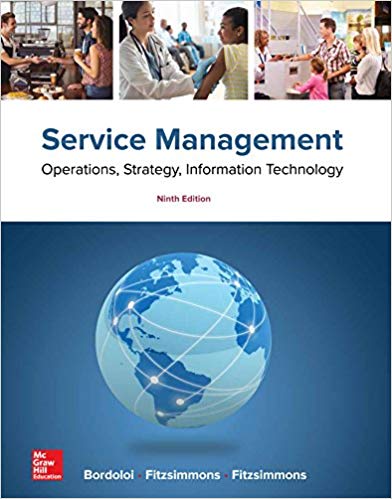Solution Manual for Service Management 9th by Bordoloi
$35.00 Original price was: $35.00.$26.50Current price is: $26.50.
Solution Manual for Service Management 9th by Bordoloi
This is completed downloadable of Solution Manual for Service Management 9th by Bordoloi

Product Details:
- ISBN-10 : 1259784630
- ISBN-13 : 978-1259784637
- Author: Sanjeev Bordoloi (Author), James Fitzsimmons (Author), Mona Fitzsimmons (Author)
This ninth edition continues to acknowledge and emphasize the essential nature of service management. Based on the research and consulting experiences of the authors, the text is organized in four parts: Part One: Understanding Services provides the historical context as well as distinguishes the distinctive characteristics of service operations; Part Two: Designing the Service Enterprise covers designing the service enterprise to support the competitive strategy; Part Three: Managing Service Operations details topics such as managing capacity, demand and waiting lines, and service supply relationships; and Part Four: Quantitative Models for Service Management addresses forecasting and managing service inventory. Each chapter emphasizes the theme of managing services for competitive advantage, which provides a focus for each management topic.
The ninth edition maintains the engaging literary style of the prior editions, and makes extensive use of examples. Emphasis is placed on the need for continuous improvement in quality and productivity in order to compete effectively in a global environment. To motivate the reader, a vignette of a well-known company starts each chapter, illustrating the strategic nature of the topic to be covered. Each chapter also has a preview, closing summary, key terms and definitions, service benchmark, topics for discussion, an interactive exercise, solved problems and exercises when appropriate, and one or more cases.
New to This Edition • In Chapter 1, a new Service Benchmark features the pioneers of the emerging sharing economy, Uber and Airbnb.• Chapter 2, Service Strategy, introduces two new topics: recent advances in the mathematical analysis of big data or data analytics and the IoT, an extension of the Internet into our everyday lives.• Chapter 3 explores a disruptive technology called blockchain based on the Internet currency Bitcoin and illustrates its impact on financial services. The stages of building a service blueprint are further illustrated by visiting a San Francisco Giants baseball game.• Chapter 7 extends the topic of Lean Service to include value-stream mapping using an example of a loan approval process.• Chapter 9 captures the emerging idea of using multiple sources and distribution methods in the concept of omnichannel supply chain.• Chapter 11 illustrates daily workshift scheduling problems using a new example: Marin County 911 Response.• Chapter 14 features an interactive Delphi exercise that engages students to forecast the date that a human colony on Mars will be established.
Table of Content:
- Part One: Understanding Services
- Chapter 1: The Service Economy
- Learning Objectives
- Chapter Preview
- Service Definitions
- Facilitating Role of Services in an Economy
- Economic Evolution
- Stages of Economic Development
- Preindustrial Society
- Industrial Society
- Postindustrial Society
- Nature of the Service Sector
- The Experience Economy
- Consumer Service Experience
- Business Service Experience
- Service-Dominant Logic
- Distinctive Characteristics of Service Operations
- Customer Participation
- Simultaneity
- Perishability
- Intangibility
- Heterogeneity
- Nontransferrable Ownership
- The Service Package
- Grouping Services by Delivery Process
- Open-Systems View of Service Operations Management
- Service Benchmark: Sharing Economy Pioneers Uber and Airbnb
- Summary
- Key Terms and Definitions
- Topics for Discussion
- Interactive Exercise
- CASE 1.1: Village Volvo
- CASE 1.2: Xpresso Lube
- Selected Bibliography
- Endnotes
- Chapter 2: Service Strategy
- Learning Objectives
- Chapter Preview
- The Strategic Service Vision
- Understanding the Competitive Environment of Services
- Competitive Service Strategies
- Overall Cost Leadership
- Differentiation
- Focus
- Strategic Analysis
- Porter’s Five Forces Analysis
- SWOT Analysis: Strengths, Weaknesses, Opportunities, Threats
- Winning Customers in the Marketplace
- Qualifiers
- Service Winners
- Service Losers
- Sustainability in Services
- Triple Bottom Line (TBL)
- The Competitive Role of Information in Services
- Creation of Barriers to Entry
- Revenue Generation
- Database Asset
- Productivity Enhancement
- The Internet of Things (IoT)
- Data Analytics in Services
- The Virtual Value Chain
- First Stage (New Processes)
- Second Stage (New Knowledge)
- Third Stage (New Products)
- Fourth Stage (New Relationships)
- Economics of Scalability
- Limits in the Use of Information
- Anticompetitive
- Fairness
- Invasion of Privacy
- Data Security
- Reliability
- Using Information to Categorize Customers
- Stages in Service Firm Competitiveness
- Available for Service
- Journeyman
- Distinctive Competence Achieved
- World-Class Service Delivery
- Service Benchmark: Outside the Box
- Summary
- Key Terms and Definitions
- Topics for Discussion
- Interactive Exercise
- CASE 2.1: United Commercial Bank and El Banco
- CASE 2.2: The Alamo Drafthouse
- Selected Bibliography
- Endnotes
- Part Two: Designing the Service Enterprise
- Chapter 3: New Service Development
- Learning Objectives
- Chapter Preview
- Sources of Service Sector Growth
- Information Technology
- The Internet as a Service Enabler
- Innovation
- Changing Demographics
- Innovation in Services
- Challenges of Adopting New Technology in Services
- Readiness to Embrace New Technology
- New Service Development
- Service Design Elements
- Strategic Positioning through Process Structure
- Service Blueprinting
- Taxonomy for Service Process Design
- Degree of Divergence
- Object of the Service Process
- Type of Customer Contact
- Generic Approaches to Service System Design
- Production-Line Approach
- Customer as Coproducer
- Customer Contact Approach
- Information Empowerment
- Intellectual Property
- Service Benchmark: Ten Things Google Has Found To Be True
- Summary
- Key Terms and Definitions
- Topics for Discussion
- Interactive Exercise
- CASE 3.1: 100 Yen Sushi House
- CASE 3.2: Commuter Cleaning—A New Venture Proposal
- CASE 3.3: Amazon.com
- Selected Bibliography
- Endnotes
- Chapter 4: The Service Encounter
- Learning Objectives
- Chapter Preview
- Technology in the Service Encounter
- The Emergence of Self-Service
- The Service Encounter Triad
- Encounter Dominated by the Service Organization
- Contact Personnel–Dominated Encounter
- Customer-Dominated Encounter
- The Service Organization
- Culture
- Empowerment
- Control Systems
- Customer Relationship Management
- Contact Personnel
- Selection
- Training
- Creating an Ethical Climate
- The Customer
- Expectations and Attitudes
- The Role of Scripts in Coproduction
- Creating a Customer Service Orientation
- Service Profit Chain
- Service Benchmark: Miss Manners on Complaint Handling
- Summary
- Key Terms and Definitions
- Topics for Discussion
- Interactive Exercise
- CASE 4.1: Amy’s Ice Cream
- CASE 4.2: Enterprise Rent-A-Car
- Selected Bibliography
- Endnotes
- Chapter 5: Supporting Facility and Process Flows
- Learning Objectives
- Chapter Preview
- Environmental Psychology and Orientation
- Servicescapes
- Behaviors in Servicescapes
- Environmental Dimensions of Servicescapes
- Facility Design
- Nature and Objectives of Service Organizations
- Land Availability and Space Requirements
- Flexibility
- Security
- Aesthetic Factors
- The Community and Environment
- Process Analysis
- Types of Processes
- Flowcharting
- Gantt Chart
- Process Terminology
- Facility Layout
- Flow Process Layout and the Work Allocation Problem
- Job Shop Process Layout and the Relative Location Problem
- Summary
- Service Benchmark: Where, Oh Where Shall We Go?
- Key Terms and Definitions
- Topics for Discussion
- Interactive Exercise
- Solved Problems
- Exercises
- CASE 5.1: Health Maintenance Organization (A)
- CASE 5.2: Health Maintenance Organization (B)
- CASE 5.3: Esquire Department Store
- CASE 5.4: Central Market
- Selected Bibliography
- Endnotes
- Chapter 6: Service Quality
- Learning Objectives
- Chapter Preview
- Defining Service Quality
- Dimensions of Service Quality
- Gaps in Service Quality
- Measuring Service Quality
- SERVQUAL
- Walk-through Audit
- Quality Service by Design
- Incorporation of Quality in the Service Package
- Taguchi Methods
- Poka-Yoke (Failsafing)
- Quality Function Deployment
- Achieving Service Quality
- Cost of Quality
- Statistical Process Control
- Unconditional Service Guarantee
- Stages in Quality Development
- Service Recovery
- Approaches to Service Recovery
- Complaint Handling Policy
- Service Benchmark: Bronson Methodist Hospital
- Summary
- Key Terms and Definitions
- Topics for Discussion
- Interactive Exercise
- Solved Problems
- Exercises
- CASE 6.1: Clean Sweep, Inc.
- CASE 6.2: The Complaint Letter
- CASE 6.3: The Helsinki Museum of Art and Design
- Selected Bibliography
- Endnotes
- Chapter 7: Process Improvement
- Learning Objectives
- Chapter Preview
- Quality and Productivity Improvement Process
- Foundations of Continuous Improvement
- Plan-Do-Check-Act (PDCA) Cycle
- Problem Solving
- Quality Tools for Analysis and Problem Solving
- Check Sheet
- Run Chart
- Histogram
- Pareto Chart
- Flowchart
- Cause-and-Effect Diagram
- Scatter Diagram
- Control Chart
- Benchmarking
- Improvement Programs
- Deming’s 14-Point Program
- ISO 9001
- Six Sigma
- Lean Service
- Service Benchmark: When Something Doesn’t Work—Sometimes Just Hit it with a Hammer!
- Summary
- Key Terms and Definitions
- Topics for Discussion
- Interactive Exercise
- CASE 7.1: Sonora County Sheriff
- CASE 7.2: Mega Bytes Restaurant
- Chapter 7 Supplement: Data Envelopment Analysis (DEA)
- Measuring Service Productivity
- The DEA Model
- DEA and Strategic Planning
- Exercises
- CASE 7.3: Mid-Atlantic Bus Lines
- Selected Bibliography
- Endnotes
- Chapter 8: Service Facility Location
- Learning Objectives
- Chapter Preview
- Strategic Location Considerations
- Competitive Clustering
- Saturation Marketing
- Marketing Intermediaries
- Substitution of Communication for Travel
- Separation of Front from Back Office
- Impact of the Internet on Service Location
- Site Considerations
- Geographic Information Systems
- Facility Location Modeling Considerations
- Geographic Representation
- Number of Facilities
- Optimization Criteria
- Facility Location Techniques
- Cross-Median Approach for a Single Facility
- Huff Model for a Retail Outlet
- Location Set Covering for Multiple Facilities
- Regression Analysis in Location Decisions
- Summary
- Service Benchmark: Here a Bun, There a Bun, Everywhere a Bun-Bun
- Key Terms and Definitions
- Topics for Discussion
- Interactive Exercise
- Solved Problems
- Exercises
- CASE 8.1: Health Maintenance Organization (C)
- CASE 8.2: Athol Furniture, Inc.
- Selected Bibliography
- Endnotes
- Part Three: Managing Service Operations
- Chapter 9: Service Supply Relationships
- Learning Objectives
- Chapter Preview
- Supply Chain Management
- Network Model
- Managing Uncertainty
- Omnichannel Supply Chain
- Service Supply Relationships
- Customer–Supplier Duality
- Service Supply Relationships Are Hubs, Not Chains
- Managing Service Relationships
- Bidirectional Optimization
- Productive Capacity
- Perishability
- Social Media in Services
- Social Media as a Competitive Strategy
- Social Media and Customer Convenience
- Social Media for Organizing and Co-creation of Value
- Professional Service Firms
- Attributes of Professional Services
- Service Consulting
- Operational Characteristics
- Outsourcing Services
- Benefits and Risks of Outsourcing Services
- Classification of Business Services
- Managerial Considerations with Service Outsourcing
- Summary
- Service Benchmark: Citizens Come First in Lynchburg
- Key Terms and Definitions
- Topics for Discussion
- Interactive Exercise
- CASE 9.1: Boomer Consulting, Inc.
- CASE 9.2: Evolution of B2C E-Commerce in Japan
- CASE 9.3: Mortgage Service Game
- Selected Bibliography
- Endnotes
- Chapter 10: Globalization of Services
- Learning Objectives
- Chapter Preview
- Domestic Growth and Expansion Strategies
- Focused Service
- Focused Network
- Clustered Service
- Diversified Network
- Franchising
- The Nature of Franchising
- Benefits to the Franchisee
- Issues for the Franchiser
- Globalization of Services
- Generic International Strategies
- The Nature of the Borderless World
- Planning Transnational Operations
- Global Service Strategies
- Multicountry Expansion
- Importing Customers
- Following Your Customers
- Service Offshoring
- Beating the Clock
- Service Benchmark: Small World and Other Myths
- Summary
- Key Terms and Definitions
- Topics for Discussion
- Interactive Exercise
- CASE 10.1: Goodwill Industries of Central Texas
- CASE 10.2: FedEx: Tiger International Acquisition
- Selected Bibliography
- Endnotes
- Chapter 11: Managing Capacity and Demand
- Learning Objectives
- Chapter Preview
- Generic Strategies of Level Capacity or Chase Demand
- Strategies for Managing Demand
- Customer-Induced Variability
- Segmenting Demand
- Offering Price Incentives
- Promoting Off-Peak Demand
- Developing Complementary Services
- Reservation Systems and Overbooking
- Strategies for Managing Capacity
- Defining Service Capacity
- Daily Workshift Scheduling
- Weekly Workshift Scheduling with Days-Off Constraint
- Increasing Customer Participation
- Creating Adjustable Capacity
- Sharing Capacity
- Cross-Training Employees
- Using Part-Time Employees
- Yield Management
- Yield Management Applications
- Service Benchmark: Pay Up Front and Take Your Chances
- Summary
- Key Terms and Definitions
- Topics for Discussion
- Interactive Exercise
- Solved Problems
- Exercises
- CASE 11.1: River City National Bank
- CASE 11.2: Gateway International Airport
- CASE 11.3: The Yield Management Analyst
- CASE 11.4: Sequoia Airlines
- Selected Bibliography
- Endnotes
- Chapter 12: Managing Waiting Lines
- Learning Objectives
- Chapter Preview
- The Economics of Waiting
- Queuing Systems
- Strategies for Managing Customer Waiting
- The Psychology of Waiting
- That Old Empty Feeling
- A Foot in the Door
- The Light at the End of the Tunnel
- Excuse Me, but I Was Next
- Essential Features of Queuing Systems
- Calling Population
- Arrival Process
- Queue Configuration
- Queue Discipline
- Service Process
- Summary
- Service Benchmark: The Magic of Disney Makes Queues Disappear
- Key Terms and Definitions
- Topics for Discussion
- Interactive Exercise
- Solved Problem
- Exercises
- CASE 12.1: Thrifty Car Rental
- CASE 12.2: Eye’ll Be Seeing You
- CASE 12.3: Field Study
- Selected Bibliography
- Endnotes
- Chapter 13: Capacity Planning and Queuing Models
- Learning Objectives
- Chapter Preview
- Capacity Planning
- Strategic Role of Capacity Decisions
- Analytical Queuing Models
- Relationships among System Characteristics
- Standard M/M/1 Model
- Standard M/M/c Model
- M/G/1 Model
- General Self-Service M/G/∞ Model
- Finite-Queue M/M/1 Model
- Finite-Queue M/M/c Model
- Capacity Planning Criteria
- Average Customer Waiting Time
- Probability of Excessive Waiting
- Minimizing the Sum of Customer Waiting Costs and Service Costs
- Probability of Sales Lost Because of Inadequate Waiting Area
- Service Benchmark: Don’t Guesstimate, Simulate!
- Summary
- Key Terms and Definitions
- Topics for Discussion
- Interactive Exercise
- Solved Problems
- Exercises
- CASE 13.1: Houston Port Authority
- CASE 13.2: Freedom Express
- CASE 13.3: Renaissance Clinic (A)
- Chapter 13 Supplement: Computer Simulation
- Systems Simulation
- Simulation Methodology
- Monte Carlo Simulation
- Generating Random Variables
- Discrete Random Variable
- Continuous Random Variable
- Discrete-Event Simulation
- Process Simulator by ProModel
- Solved Problems
- Exercises
- CASE 13.4: Drivers License Renewal
- CASE 13.5: Renaissance Clinic (B)
- Selected Bibliography
- Endnotes
- Part Four: Quantitative Models for Service Management
- Chapter 14: Forecasting Demand for Services
- Learning Objectives
- Chapter Preview
- The Choice of Forecasting Method
- Subjective Models
- Delphi Method
- Cross-Impact Analysis
- Historical Analogy
- Causal Models
- Regression Models
- Econometric Models
- Time Series Models
- N-Period Moving Average
- Simple Exponential Smoothing
- Forecast Error
- Relationship Between α and N
- Exponential Smoothing with Trend Adjustment
- Exponential Smoothing with Seasonal Adjustment
- Exponential Smoothing with Trend and Seasonal Adjustments
- Summary of Exponential Smoothing
- Summary
- Service Benchmark: Googling the Future
- Key Terms and Definitions
- Topics for Discussion
- Interactive Exercise
- Solved Problems
- Exercises
- CASE 14.1: Oak Hollow Medical Evaluation Center
- CASE 14.2: Gnomial Functions, Inc.
- Selected Bibliography
- Endnotes
- Chapter 15: Managing Service Inventory
- Learning Objectives
- Chapter Preview
- Inventory Theory
- Role of Inventory in Services
- Characteristics of Inventory Systems
- Relevant Costs of an Inventory System
- Order Quantity Models
- Economic Order Quantity
- Inventory Model with Quantity Discounts
- Inventory Model with Planned Shortages
- Inventory Management under Uncertainty
- Inventory Control Systems
- Continuous Review System
- Periodic Review System
- The ABCs of Inventory Control
- Radio Frequency Identification
- Single-Period Model for Perishable Goods
- Expected Value Analysis
- Marginal Analysis
- Retail Discounting Model
- Service Benchmark: Your Bag Is Tagged
- Summary
- Key Terms and Definitions
- Topics for Discussion
- Interactive Exercise
- Solved Problems
- Exercises
- CASE 15.1: A.D. Small Consulting
- CASE 15.2: Last Resort Restaurant
- CASE 15.3: Elysian Cycles
- Selected Bibliography
- Endnotes
- Chapter 16: Managing Service Projects
- Learning Objectives
- Chapter Preview
- The Nature of Project Management
- Characteristics of Projects
- Project Management Process
- Selecting the Project Manager
- Building the Project Team
- Principles of Effective Project Management
- Techniques for Project Management
- Gantt Project Charts
- A Critique of Gantt Charts
- Constructing a Project Network
- Critical Path Method
- Microsoft Project Analysis
- Resource Constraints
- Activity Crashing
- Incorporating Uncertainty in Activity Times
- Estimating Activity Duration Distributions
- Project Completion Time Distribution
- A Critique of the Project Completion Time Analysis
- Problems with Implementing Critical Path Analysis
- Monitoring Projects
- Earned Value Chart
- Project Termination
- Project History Report
- Service Benchmark: The House That Warren Built
- Summary
- Key Terms and Definitions
- Topics for Discussion
- Interactive Exercise
- Solved Problems
- Exercises
- CASE 16.1: Info-Systems, Inc.
- CASE 16.2: Whittier County Hospital
- Selected Bibliography
- Endnote
- Appendix A: Areas of Standard Normal Distribution
- Appendix B: Uniformly Distributed Random Numbers [0, 1]
- Appendix C: Values of Lq for the M/M/c Queuing Model
- Appendix D: Equations for Selected Queuing Models
- Name Index
- Subject Index
People Also Search:
service management 9th
service management 9th by bordoloi
service management 9th by bordoloi download scribd
service management 9th by bordoloi solution manual download pdf
Related products
Solution Manual
Solution Manual for Introduction to Electrodynamics, 4/E 4th
Solution Manual
Solution manual for Accounting: Tools for Business Decision Making Kimmel Weygandt Kieso 5th Edition
Solution Manual
International Accounting Doupnik 4th Edition Solutions Manual
Solution Manual
Understanding Business Nickels 10th Edition Solutions Manual
Solution Manual
International Business Competing in the Global Marketplace Hill 10th Edition Solutions Manual
Solution Manual
Solution Manual for Data Structures and Other Objects Using C++, 4/E Michael Main, Walter Savitch











